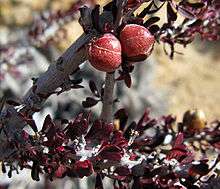Tetracoccus hallii
Tetracoccus hallii is a species of flowering shrub in the family Picrodendraceae, known by the common names Hall's shrubby-spurge[1] and Hall's tetracoccus.
| Tetracoccus hallii | |
|---|---|
 | |
| Scientific classification | |
| Kingdom: | Plantae |
| Clade: | Tracheophytes |
| Clade: | Angiosperms |
| Clade: | Eudicots |
| Clade: | Rosids |
| Order: | Malpighiales |
| Family: | Picrodendraceae |
| Genus: | Tetracoccus |
| Species: | T. hallii |
| Binomial name | |
| Tetracoccus hallii | |
Distribution
The plant is native to the Mojave Desert and Sonoran Desert: in southeastern California, southern Nevada, and western Arizona in the U.S.; and Baja California state in Mexico.[2]
It grows in many types of desert habitat, including creosote bush scrub, at elevations below 1,200 metres (3,900 ft).
It is abundant and widespread in Joshua Tree National Park in Southern California.[3]
Description
Tetracoccus hallii is a bushy, branching shrub, hairless in texture except for the new twigs, which have rough hairs. The small leaves occur in clusters along the branches, each leathery, teardrop-shaped leaf measuring just a few millimeters long.
The plant is dioecious, with male and female individuals producing different types of flowers. The staminate flowers occur in clusters, each flower with 4 to 6 rounded sepals and 4 to 8 erect stamens. The pistillate flower occurs singly. Its bloom period is January through May, from the lower Sonoran to the higher Mojave deserts.
It produces a rounded, woolly fruit with usually three chambers. The fruit is around a centimeter long when mature and contains one or two seeds per chamber.
See also
- Flora of the Sonoran Deserts
- Natural history of the Mojave Desert
References
- "Tetracoccus hallii". Natural Resources Conservation Service PLANTS Database. USDA. Retrieved 8 December 2015.
- "Tetracoccus hallii". Germplasm Resources Information Network (GRIN). Agricultural Research Service (ARS), United States Department of Agriculture (USDA). Retrieved 19 January 2018.
- Miriti, M. N. (2007). Twenty years of changes in spatial association and community structure among desert perennials. Ecology 88:5 1177-90.
External links
- Calflora Database: Tetracoccus hallii (Hall's purple bush, Hall's shrubby spurge, Holly leaved spurge)
- Jepson Manual eFlora (TJM2) treatment of Tetracoccus hallii
- USDA Plants Profile for Tetracoccus hallii (Hall's shrubby-spurge)
- UC CalPhotos gallery of Tetracoccus hallii